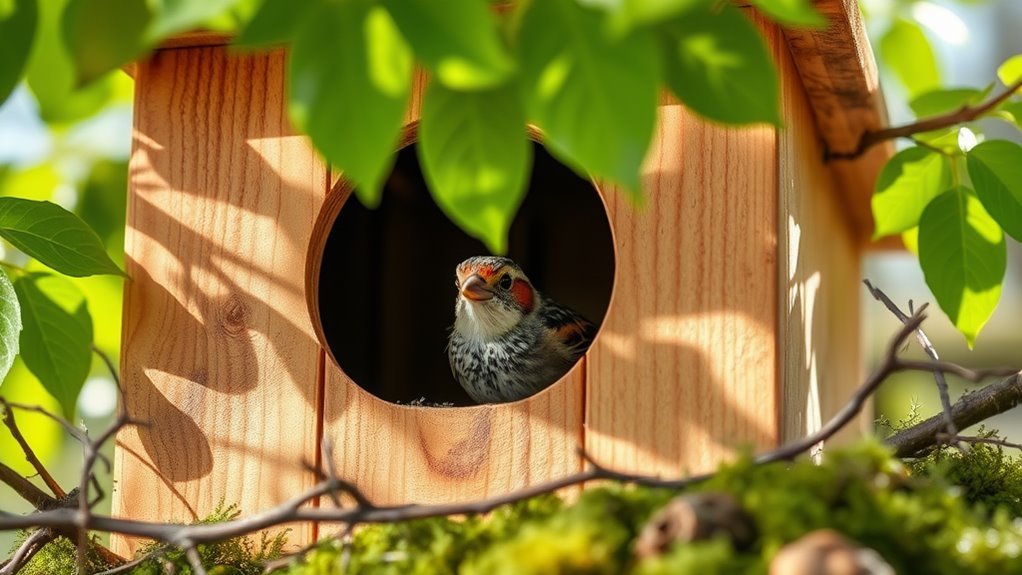What’s the Best Material to Build or Buy a Bird Nest Box?
When choosing the best material for a bird nest box, consider the needs of the bird species and your local environment. Untreated wood, metal, and recycled plastics each have benefits. Untreated wood provides natural insulation, metal offers durability, and recycled plastics support sustainability. These factors can impact the health of local bird populations. Let's look at each material option to help you decide what is best for your backyard.
Key Takeaways
- Untreated wood, such as cedar or pine, is strong. It mimics natural habitats, making it a popular choice for many birds.
- Metal provides long-lasting protection against weather and predators. Rust-resistant options ensure durability with little maintenance.
- Recycled plastics are eco-friendly. They come from post-consumer waste, promoting sustainability while resisting moisture and pests.
- Make sure the nest box has ventilation and drainage holes. This is important for airflow and moisture control, no matter the material.
- Regular maintenance and easy cleaning access are key. They help keep the nest box effective and hygienic over time.
Understanding the Importance of Material Selection
Choosing materials for a bird nest box is important for the nesting process. Each material affects the box's durability and its suitability for different bird species.
Some birds like natural, untreated wood, while others may prefer synthetic materials that resemble their habitats. Using eco-friendly materials promotes responsibility towards nature.
It's also essential to consider the preferences of the bird species you want to attract. By selecting the right materials, you can improve the chances of successful nesting and support a healthy bird community.
This connection with nature can be rewarding for you as well.
Wood: The Classic Choice for Bird Nest Boxes
Wood is the preferred choice for building bird nest boxes. It offers durability and a natural look that many birds like.
Choose untreated cedar or pine, as both resist rot and insulate well. Ensure the nest box design includes ventilation and drainage holes. This creates a comfortable living space for the birds.
Wood's texture makes birds feel secure, similar to their natural habitat. Select a strong material that endures weather conditions while allowing for easy cleaning.
By providing a welcoming environment, you can attract various bird species to your backyard. This connection to nature can enrich your community.
Embrace wood for your bird nest boxes to make a positive impact.
Metal: Durability and Longevity
Metal is a strong choice for building bird nest boxes because it lasts a long time and withstands harsh weather. When you select metal, you create a safe home for birds that can endure the elements year after year.
Here are some clear benefits:
- Rust Resistance: Good quality metals resist rust, keeping the box in great shape.
- Temperature Control: Metal reflects heat, helping keep nests cool in summer and warm in winter.
- Predator Protection: The solid build of metal helps guard against predators.
- Easy Maintenance: Metal requires less upkeep than wood, saving you time and effort.
Choosing metal for bird nest boxes helps build a lasting home for birds. This choice connects you to nature and shows your commitment to wildlife conservation.
Recycled Plastics: Eco-Friendly Options
Recycled plastics provide an eco-friendly option for bird nest boxes. Choosing recycled plastics helps create safe habitats for birds and supports environmental sustainability.
These materials come from post-consumer waste, which reduces landfill waste and conserves resources.
Recycled plastics resist moisture and pests, making your nest box durable and easy to maintain. They're available in various colors and designs, allowing you to showcase your style while aiding wildlife.
Comparing Insulation Properties of Different Materials
When choosing materials for bird nest boxes, it's important to consider insulation properties. These properties affect the comfort and survival of nesting birds.
Here is a simple comparison of insulation efficiency and temperature control for common materials:
- Wood: Provides good insulation and regulates temperature well. However, wood can warp over time.
- Recycled Plastics: Lightweight and offers decent insulation. It's resistant to moisture but may not allow for air circulation.
- Metal: Very durable but has poor insulation. This can lead to extreme temperatures inside the box.
- Straw or Hay: Great natural insulators that keep nests warm. They require regular maintenance to stay effective.
Choosing the right material helps create a comfortable home for birds in your backyard. This choice supports their well-being and encourages them to nest.
Aesthetic Considerations for Your Backyard
Creating a bird-friendly backyard involves more than just installing nest boxes; it also means considering their appearance. Choose colors that match your garden for a pleasing look. Earthy tones like brown and green blend well with nature, while brighter colors can bring fun and excitement.
Explore different styles, such as rustic, modern, or cottage, to showcase your personality. A well-chosen nest box attracts birds and adds charm to your yard. It can become a focal point that enhances your outdoor space.
Maintenance and Longevity of Nest Box Materials
Choosing the right materials for your bird nest box is important for its maintenance and lifespan. You want to provide a safe space for birds. Here are four key factors to consider:
- Material durability: Choose weather-resistant materials like cedar or marine-grade plywood. These options can handle different weather conditions.
- Ease of cleaning: Look for designs that allow easy access for cleaning. Regular cleaning helps maintain hygiene in the nest box.
- Insulation properties: Ensure the materials offer good insulation. This protects birds from extreme temperatures.
- Pest resistance: Select materials that keep pests away. This helps protect the nest and its inhabitants.
Frequently Asked Questions
Can I Use Untreated Wood for Building Bird Nest Boxes?
Yes, you can use untreated wood to build bird nest boxes. Cedar and pine are good choices. Make sure to include suitable nesting materials inside to attract birds and encourage them to use your box.
Are There Specific Sizes for Nest Boxes Based on Bird Species?
Yes, nest box sizes vary depending on the bird species. Smaller birds, like wrens, prefer compact boxes. Larger birds, such as owls, need more space. Check specific dimensions for each species to ensure they can nest successfully.
How Often Should I Clean My Bird Nest Box?
Clean your bird nest box at least once a year, preferably after nesting season. This will create a healthy space for future birds and keep your yard welcoming for them. Regular cleaning helps prevent the build-up of dirt and parasites, making it safer for new inhabitants. Enjoy watching your feathered friends return to a clean and inviting home!
Will Using Bright Colors Deter Birds From Nesting?
Using bright colors may stop birds from nesting because many birds prefer softer tones. Knowing which colors birds like can help you design birdhouses that attract them. This understanding creates a friendly space for your feathered friends.
Can I Use Recycled Materials Other Than Plastics for Nest Boxes?
Yes, you can use recycled materials like wood and metal for nest boxes. Recycled wood offers good insulation, and metal provides strength. Ensure that all materials are safe and free from harmful chemicals to protect the birds. Using these materials is a smart choice for building nest boxes while helping the environment.

Ava is a bird enthusiast and nature lover who has spent countless hours observing and learning about the fascinating world of birds. With a passion for sharing her knowledge and inspiring others to appreciate the beauty of birds, Ava writes about her experiences and insights on avianadmirer.com.







